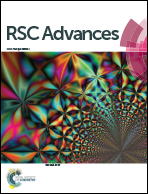Block copolymer-guided fabrication of shuttle-like polyaniline nanoflowers with radiating whiskers for application in supercapacitors
Abstract
Superfine shuttle-shaped polyaniline (PANI) nanoflowers with radiating whiskers at the edge of the flowers have been synthesized using a block copolymer-assisted reverse microemulsion system. The copolymer poly(ethylene oxide)-block-poly(propylene oxide)-block-poly(ethylene oxide) (P123) served as the surfactant stabilizing reverse micelles for regular assembly of the flower-like structures. The flowers formed had widths of ca. 40–150 nm and lengths of ca. 80–180 nm, far less than the typical sizes reported (over several microns). The correlation between some important factors (polymerization method, P123 and aniline concentrations, and reaction time) and the morphology was discussed, and a plausible mechanism for formation of the nanoflowers was put forward. More importantly, the unique architecture showed good electrochemical properties with a high reversible capacitance (622 F g−1 at 0.5 A g−1, and 484 F g−1 at 2 A g−1) and good durability (76% capacitance retention at 5 A g−1 after 1000 cycles) due to the nano size and V-type channels. These characteristics make it promising for supercapacitor applications.


 Please wait while we load your content...
Please wait while we load your content...